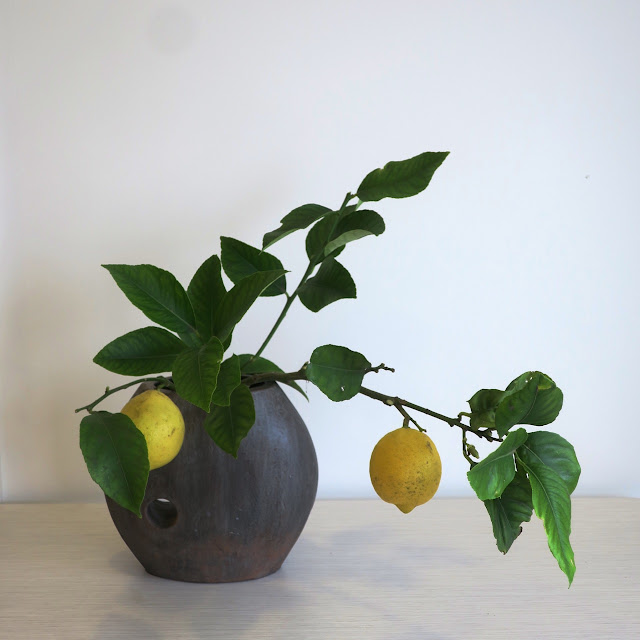On May the 27th, my students in Geelong each had a different exercise to complete. It was interesting to see the variety of ikebana created as well as the strength of design.
The exercise for Tess was an ikebana expressing movement. She chose 'Bubbling Over'. She has set her materials in two matching contemporary-styled vessels. The lines are Xanthorrhoea and the two masses created with Gypsophila.
Maree's exercise was Variation No 8, using two cylindrical nageire vases. The arrangement in each of the vases is a discrete exercise from earlier in the curriculum. They are combined to make a single ikebana. I think the branches with bright orange berries are one of the many Cotoneasters and the flowers, Proteas.
Helen M's exercise was to make 'Miniature Ikebana', a concept developed by the second Sogetsu Iemoto, Kasumi Teshigahara. Each miniature 'vessel' contains only elements of a plant on which the ikebanist has chosen to focus. They are not tiny individual ikebana arrangements. Instead the group is seen as a whole with multiple points of interest.
Helen had brought enough material and vessels to make a second set.
The exercise I set for Ellie was 'Inspired by Music'. When ikebana is made on a theme removed from the world of botanical materials, Japanese festivals or the seasons, they should be appreciated simply in design terms. The exercise I set is not a guessing game to identify the source of the ikebanist's inspiration. However, Ellie told us that her inspiration for this first work was the 'trial scene' from Verdi's 'Aida'.
This second work that Ellie created was quite abstract. Her inspiration was the third movement, Adagio, 'Eternal Memory' from the 11th Symphony of Shostakovich.
* * * * *
This morning I heard some noisy chirping in the garden...
They were after the nectar in the many blooms at this time of year.
Also in the garden some of the leaves on the Hydrangeas are developing strong red patches before they fall.
One Hydrangea colours very strongly with the onset of the cold weather while, surprisingly, another produced a very late new pink flower. I think it has flowered late because I pruned it too hard last winter.
The two flowers from different pots were growing very close together. I thought they would continue to look lovely in a vase and last a little longer than on the bush. I have created a mass with the flowers and removed almost all the leaves. The ikebana vessel, which I bought in Kiso-Fukushima, is made from lacquered linen. I was told the inspiration for the vessel was the lacquered helmets worn by firefighters in the Edo period. The maker is Hiroyasu Takizawa.
Greetings from Christopher
13th June 2021



































